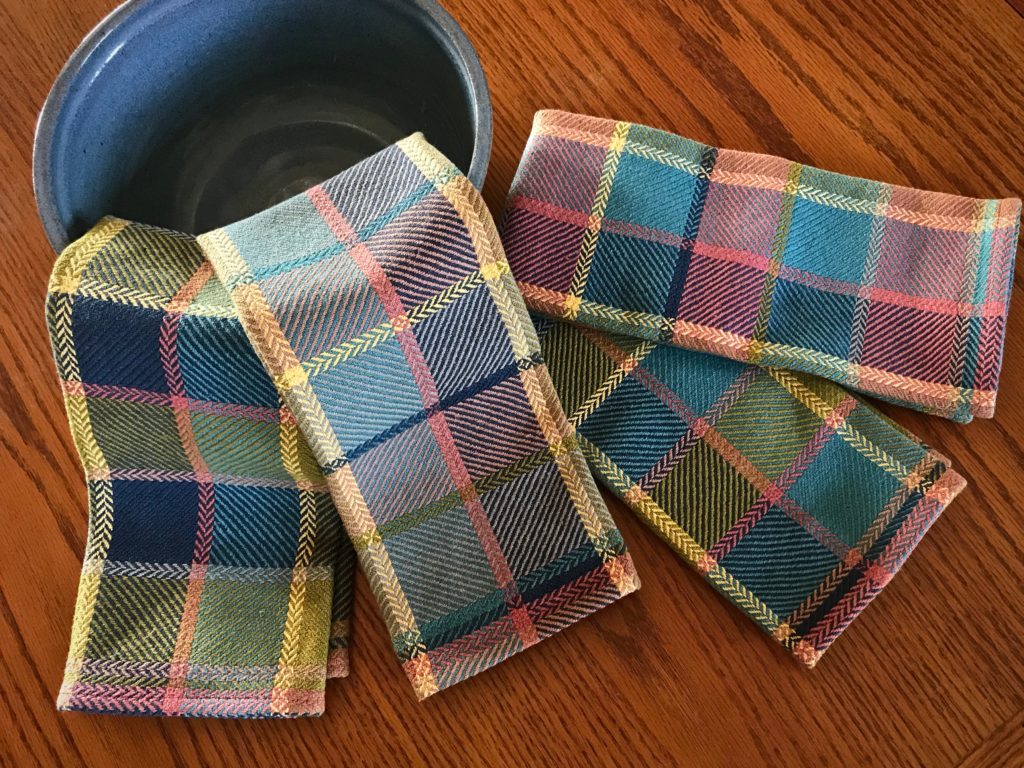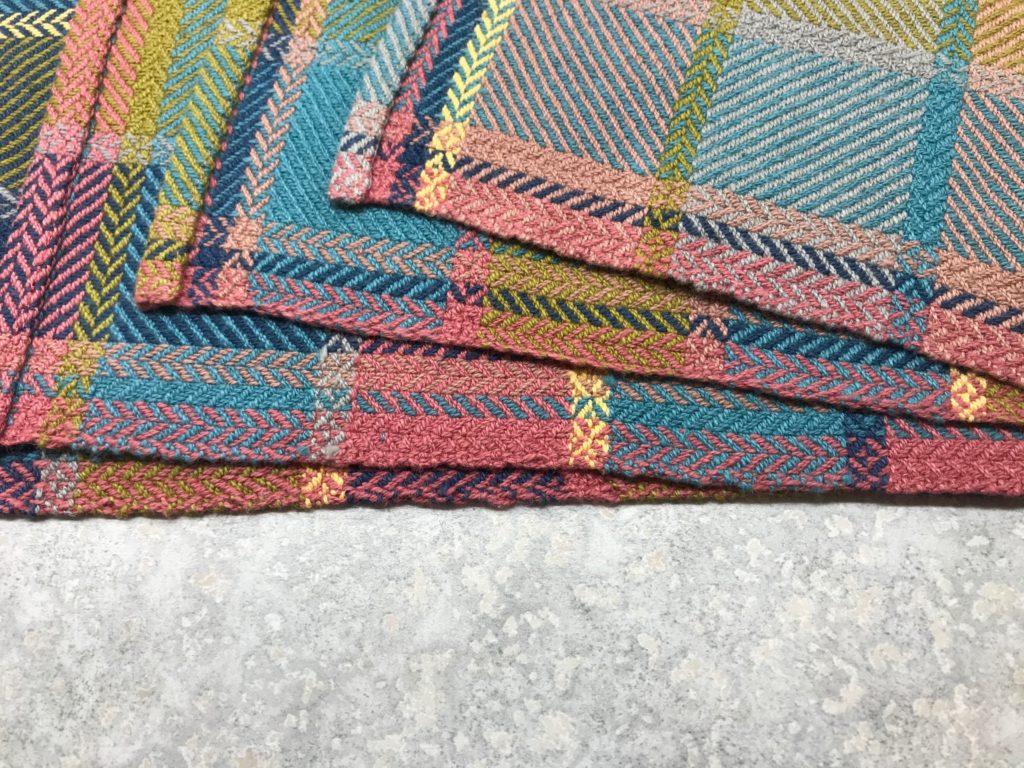These towels make me think of my father. He was a brilliant architect. As an architect’s daughter, I learned to appreciate the interaction of structure, design, and color. This fabric has it all! These towels are also an expression of joy, a prominent aspect of my dad’s personality. If you could create a tangible article of jubilation, this would be it.

After weaving three towels, I eliminated the floating selvedges. Which one of the four towels do you think was woven without floating selvedges? Leave your answer in the comments. (1 – 4, with the towel on top as #1.)

Here’s a short slideshow video that shows the process from start to finish:
Jubilation bath towels are up next on the Glimåkra Standard!
May your jubilation rub off on your family and friends.
Happy Weaving,
Karen

Number 4
Thanks for making a guess!
Karen
They are all beautiful!
I think it is number 4 that didn’t have a floating selvage. I know those edges anywhere! Ha ha
Hi Nancy, I’m glad you like the towels. Thanks for guessing. I will reveal the answer next week.
Happy weaving,
Karen
The towels are gorgeous ! I think I would have liked to have met your father…….
!
Hi Kristin, I’m sure you would have enjoyed my father. He was a very likable guy. Thank you for your compliment on the towels!
All the best,
Karen
The richness in color and design…goodness…gracious…such beauty have you created! I and going with #3, to be the one without a floating selvage.
Hi Charlotte, Your encouraging words mean a lot to me. Thanks for making a guess. Stay tuned… I will reveal the answer next week.
Happy weaving,
Karen
They are beautiful, Karen!
Hi Beth, Thank you! And I know your great success in weaving includes floating selvedges. I admire you for that.
Happy weaving,
Karen
I believe it is 4. My question is why? These towels are stunning. Thanks for sharing.
Hi Rachel, If your question is why would I eliminate the floating selvedges, I have a few reasons. Primarily, though, I can get a much better rhythm in weaving without them. And in most cases, I find they are unnecessary.
Happy weaving,
Karen
My guess is #2. Only because it looks a little different than the others. Did you start out without one and then decide it would be A little easier to use one?
Hi Jenny, I started out with the floating selvedges because I thought I needed them because of the reverse twill. After three towels I decided to chance it and cut the floating selvedges off. I was pleasantly surprised. It leaves only small floats at the selvedge (which are unnoticeable after wet finishing), and it was much easier for me to weave without them. I only had to toss and catch the shuttle, so my hands didn’t have to stay so close to the warp.
Thanks for making a guess. I’ll reveal the answer next week.
Happy weaving,
Karen
What a glorious video Karen… the loom, the threading, the weaving and the music brought me great joy this morning. Be safe and well! You are loved!
Bethany in Kingston, ON Canada
Hi Bethany, It warms my heart that you received the video with joy.
Love,
Karen
I’m guessing #2. These towels are gorgeous, Karen! The video with all of its loveliness brought a smile to my face this morning (and I needed it – I was feeling like a grump!) Your father sounds like such a wonderful man. Thank you for spreading joy today 🙂
Hi Kristin, Well, I’m glad this had that effect on you because the world needs your beautiful smile! You would have liked my father, and I know he would have liked you.
Thanks for your guess. Stayed tuned for next week….
Hugs,
Karen
Good morning Karen. Your craftsmanship is so precise I couldn’t pick out the missing salvage with a laser pointer and a flashing neon light.
Good morning, Nannette, You have a way with words. Thanks for bringing me a smile this morning. 🙂
Karen
The towels are lovely. Your colors are always so interesting. If I am not being too forward, your edge in the picture where the towel is still on the look looks so firm. Would you share how you did this? Thank you, Loyanne
Hi Loyanne, It’s good to hear from you.
While on the loom, the edges stay firm for two reasons. 1. I generally keep the tension fairly tight. This is especially possible with a countermarch loom. 2. I always use a temple. The temple helps me weave tight selvedges—the weft is very snug at the selvedge, which helps keep the outer warp ends firm.
I hope that makes sense.
Happy weaving,
Karen
Thank you.
These are lovely. Cam you share what yarn you used?
Hi Jane, Thank you for asking. The warp and weft is 22/2 Bockens Nialin (Cottolin). The cotton and linen blend is perfect for making absorbent towels.
Happy weaving,
Karen
Well, I LIKE the edge of number 2 the best. Where is the pattern from, how many shafts and what are the were and warp threads? Absolutely stunning!
Hi Kim, Thanks! I like knowing what you like the best.
I started with a draft for wool blankets from Favorite Scandinavian Projects to Weave, by Tina Ignell. I adjusted it for size and sett to make the towels, and chose my own colors. This uses 6 shafts and 6 treadles. Cottolin for warp and weft.
Thank you!
Karen
Your towels are beautiful! Beautiful colors and fabulous weaving! I’m guessing #4 is the one without the floating selvage.
Hi Kevin, I have enjoyed these colors immensely. It’s fun to find a set of colors to play around with. Thanks for making a guess! I’ll let you know the answer next week…
Thanks for your sweet encouragement.
Karen
I suspect you inherited your father’s precise workmanship and creativity as your work is always exquisite. He sounds like a delightful father. I think #2 is the one without the floating selvedge, but I look forward to your answer. 🙂
Hi D’Anne, Your cheerful encouragement means so much to me! If I inherited my dad’s workmanship and creativity that’s saying a lot. You have a keen eye. We’ll see if you’re right about the selvedges.
All the best,
Karen
Beautiful towels Karen. I think No 1 is the one without the floating selvedge.
Hi Jan, Thanks for putting in your vote! Thanks for your compliment, too.
All the best,
Karen
My guess is #4. I always use a FS with twill and it makes me laugh that I am having such a hard time seeing the difference! Beautiful towels!!!
Hi Linda, Floating selvedges are very common. I’m pleased to know that it is not easy to tell the difference. Weaving is far simpler for me without them. Thank you!!
Happy weaving,
Karen
My goodness! These towels are just stunning, color, pattern, all of it! My guess is number 2. It just looks different form the other three, and I prefer the look of that edge!
Hi Kat, Your descriptive words really warm my heart! I’m glad these towels look good to you.
Thanks for including your guess – and your reasons.
All the best,
Karen
Hi Karen,
Your towels are wonderful. I love the combination of reverse and broken twill.
Is this your original pattern or is it from another source?
The video was enjoyable to watch as well.
Can’t wait to see what your Jubilation towel project will be!
Regards, Janis
Hi Janis, I’m very happy with the reverse and broken twill combination. It puts a lot of action in the design.
I started with a pattern for wool blankets in Favorite Scandinavian Projects to Weave, by Tina Ignell, and made adjustments to turn it into towels.
The next Jubilation Towels will be very similar, only bigger! Bath size.
Happy weaving,
Karen
Your towels are beautiful! Nothing beats the feel of hand wowen towels, I am sure they will be wonderful as bath towels, too 🙂
My guess is # 2, for two reasons… the edge looks different, and I think I recognize the colors from the last towel you wove where you made this change.
Hi Elisabeth, Thanks for adding your thoughtful guess.
I agree, handwoven towels are a pleasure to feel and use!
Happy weaving,
Karen
Hi Karen-The towels are beautiful but I have a question about rag rugs. I cleaned out my linen closet and discovered I have too many sheets and think they will make very good rugs. I plan to cut them in strips and dye them. My question is how wide should I make these strips–1 inch/2 inches? These are older cotton sheets so are pretty soft. What do you think? And thanks for advice!
Hi Tobie, That’s great that you have cotton sheets that you can use for rag rugs. I recommend you test some different widths of strips after you get the loom warped before you cut all the strips. I use a sett of 8 epi (3 epc) with 12/6 cotton rug warp. Most of my fabric strips are 3/4″ wide. If the fabric is thin, I cut them a little wider, up to 1 inch. If you want thicker weft, 2 thinner weft strips will pack in and lay better than one wider strip. Most of the Swedish rag rug books I refer to use fabric cut to 2cm (about 3/4″), so that’s what I try to follow.
Happy weaving,
Karen
Thanks so much!
Number 2. Gorgeous towels.
Hi Lora, Thanks for giving your guess. I am glad you like the towels!
Thank you!
Karen